+ Open data
Open data
- Basic information
Basic information
| Entry | Database: EMDB / ID: EMD-22456 | ||||||||||||||||||||||||
|---|---|---|---|---|---|---|---|---|---|---|---|---|---|---|---|---|---|---|---|---|---|---|---|---|---|
| Title | Structure of the NaCT-PF2 complex | ||||||||||||||||||||||||
 Map data Map data | NaCT-PF2 complex | ||||||||||||||||||||||||
 Sample Sample |
| ||||||||||||||||||||||||
 Keywords Keywords | Transporter / Inhibitor / MEMBRANE PROTEIN | ||||||||||||||||||||||||
| Function / homology |  Function and homology information Function and homology informationoxaloacetate transport / organic acid:sodium symporter activity / fumarate transport / succinate transport / sodium:dicarboxylate symporter activity / citrate transmembrane transporter activity / citrate transport / Sodium-coupled sulphate, di- and tri-carboxylate transporters / alpha-ketoglutarate transport / succinate transmembrane transporter activity ...oxaloacetate transport / organic acid:sodium symporter activity / fumarate transport / succinate transport / sodium:dicarboxylate symporter activity / citrate transmembrane transporter activity / citrate transport / Sodium-coupled sulphate, di- and tri-carboxylate transporters / alpha-ketoglutarate transport / succinate transmembrane transporter activity / cellular response to lithium ion / transmembrane transport / nucleoplasm / identical protein binding / plasma membrane / cytosol Similarity search - Function | ||||||||||||||||||||||||
| Biological species |  Homo sapiens (human) Homo sapiens (human) | ||||||||||||||||||||||||
| Method | single particle reconstruction / cryo EM / Resolution: 3.12 Å | ||||||||||||||||||||||||
 Authors Authors | Sauer DB / Wang B | ||||||||||||||||||||||||
| Funding support |  United States, 7 items United States, 7 items
| ||||||||||||||||||||||||
 Citation Citation |  Journal: Nature / Year: 2021 Journal: Nature / Year: 2021Title: Structure and inhibition mechanism of the human citrate transporter NaCT. Authors: David B Sauer / Jinmei Song / Bing Wang / Jacob K Hilton / Nathan K Karpowich / Joseph A Mindell / William J Rice / Da-Neng Wang /  Abstract: Citrate is best known as an intermediate in the tricarboxylic acid cycle of the cell. In addition to this essential role in energy metabolism, the tricarboxylate anion also acts as both a precursor ...Citrate is best known as an intermediate in the tricarboxylic acid cycle of the cell. In addition to this essential role in energy metabolism, the tricarboxylate anion also acts as both a precursor and a regulator of fatty acid synthesis. Thus, the rate of fatty acid synthesis correlates directly with the cytosolic concentration of citrate. Liver cells import citrate through the sodium-dependent citrate transporter NaCT (encoded by SLC13A5) and, as a consequence, this protein is a potential target for anti-obesity drugs. Here, to understand the structural basis of its inhibition mechanism, we determined cryo-electron microscopy structures of human NaCT in complexes with citrate or a small-molecule inhibitor. These structures reveal how the inhibitor-which binds to the same site as citrate-arrests the transport cycle of NaCT. The NaCT-inhibitor structure also explains why the compound selectively inhibits NaCT over two homologous human dicarboxylate transporters, and suggests ways to further improve the affinity and selectivity. Finally, the NaCT structures provide a framework for understanding how various mutations abolish the transport activity of NaCT in the brain and thereby cause epilepsy associated with mutations in SLC13A5 in newborns (which is known as SLC13A5-epilepsy). | ||||||||||||||||||||||||
| History |
|
- Structure visualization
Structure visualization
| Movie |
 Movie viewer Movie viewer |
|---|---|
| Structure viewer | EM map:  SurfView SurfView Molmil Molmil Jmol/JSmol Jmol/JSmol |
| Supplemental images |
- Downloads & links
Downloads & links
-EMDB archive
| Map data |  emd_22456.map.gz emd_22456.map.gz | 93 MB |  EMDB map data format EMDB map data format | |
|---|---|---|---|---|
| Header (meta data) |  emd-22456-v30.xml emd-22456-v30.xml emd-22456.xml emd-22456.xml | 13.4 KB 13.4 KB | Display Display |  EMDB header EMDB header |
| Images |  emd_22456.png emd_22456.png | 94.2 KB | ||
| Filedesc metadata |  emd-22456.cif.gz emd-22456.cif.gz | 6 KB | ||
| Archive directory |  http://ftp.pdbj.org/pub/emdb/structures/EMD-22456 http://ftp.pdbj.org/pub/emdb/structures/EMD-22456 ftp://ftp.pdbj.org/pub/emdb/structures/EMD-22456 ftp://ftp.pdbj.org/pub/emdb/structures/EMD-22456 | HTTPS FTP |
-Validation report
| Summary document |  emd_22456_validation.pdf.gz emd_22456_validation.pdf.gz | 483.9 KB | Display |  EMDB validaton report EMDB validaton report |
|---|---|---|---|---|
| Full document |  emd_22456_full_validation.pdf.gz emd_22456_full_validation.pdf.gz | 483.4 KB | Display | |
| Data in XML |  emd_22456_validation.xml.gz emd_22456_validation.xml.gz | 6.8 KB | Display | |
| Data in CIF |  emd_22456_validation.cif.gz emd_22456_validation.cif.gz | 7.9 KB | Display | |
| Arichive directory |  https://ftp.pdbj.org/pub/emdb/validation_reports/EMD-22456 https://ftp.pdbj.org/pub/emdb/validation_reports/EMD-22456 ftp://ftp.pdbj.org/pub/emdb/validation_reports/EMD-22456 ftp://ftp.pdbj.org/pub/emdb/validation_reports/EMD-22456 | HTTPS FTP |
-Related structure data
| Related structure data |  7jsjMC  7jskC M: atomic model generated by this map C: citing same article ( |
|---|---|
| Similar structure data |
- Links
Links
| EMDB pages |  EMDB (EBI/PDBe) / EMDB (EBI/PDBe) /  EMDataResource EMDataResource |
|---|
- Map
Map
| File |  Download / File: emd_22456.map.gz / Format: CCP4 / Size: 103 MB / Type: IMAGE STORED AS FLOATING POINT NUMBER (4 BYTES) Download / File: emd_22456.map.gz / Format: CCP4 / Size: 103 MB / Type: IMAGE STORED AS FLOATING POINT NUMBER (4 BYTES) | ||||||||||||||||||||||||||||||||||||||||||||||||||||||||||||||||||||
|---|---|---|---|---|---|---|---|---|---|---|---|---|---|---|---|---|---|---|---|---|---|---|---|---|---|---|---|---|---|---|---|---|---|---|---|---|---|---|---|---|---|---|---|---|---|---|---|---|---|---|---|---|---|---|---|---|---|---|---|---|---|---|---|---|---|---|---|---|---|
| Annotation | NaCT-PF2 complex | ||||||||||||||||||||||||||||||||||||||||||||||||||||||||||||||||||||
| Projections & slices | Image control
Images are generated by Spider. | ||||||||||||||||||||||||||||||||||||||||||||||||||||||||||||||||||||
| Voxel size | X=Y=Z: 1.073 Å | ||||||||||||||||||||||||||||||||||||||||||||||||||||||||||||||||||||
| Density |
| ||||||||||||||||||||||||||||||||||||||||||||||||||||||||||||||||||||
| Symmetry | Space group: 1 | ||||||||||||||||||||||||||||||||||||||||||||||||||||||||||||||||||||
| Details | EMDB XML:
CCP4 map header:
| ||||||||||||||||||||||||||||||||||||||||||||||||||||||||||||||||||||
-Supplemental data
- Sample components
Sample components
-Entire : Dimer of NaCT in complex with PF2
| Entire | Name: Dimer of NaCT in complex with PF2 |
|---|---|
| Components |
|
-Supramolecule #1: Dimer of NaCT in complex with PF2
| Supramolecule | Name: Dimer of NaCT in complex with PF2 / type: organelle_or_cellular_component / ID: 1 / Parent: 0 / Macromolecule list: #1 |
|---|---|
| Source (natural) | Organism:  Homo sapiens (human) Homo sapiens (human) |
| Molecular weight | Theoretical: 125 KDa |
-Macromolecule #1: Solute carrier family 13 member 5
| Macromolecule | Name: Solute carrier family 13 member 5 / type: protein_or_peptide / ID: 1 / Number of copies: 2 / Enantiomer: LEVO |
|---|---|
| Source (natural) | Organism:  Homo sapiens (human) Homo sapiens (human) |
| Molecular weight | Theoretical: 63.110812 KDa |
| Recombinant expression | Organism:  Trichoplusia ni (cabbage looper) Trichoplusia ni (cabbage looper) |
| Sequence | String: MASALSYVSK FKSFVILFVT PLLLLPLVIL MPAKFVRCAY VIILMAIYWC TEVIPLAVTS LMPVLLFPLF QILDSRQVCV QYMKDTNML FLGGLIVAVA VERWNLHKRI ALRTLLWVGA KPARLMLGFM GVTALLSMWI SNTATTAMMV PIVEAILQQM E ATSAATEA ...String: MASALSYVSK FKSFVILFVT PLLLLPLVIL MPAKFVRCAY VIILMAIYWC TEVIPLAVTS LMPVLLFPLF QILDSRQVCV QYMKDTNML FLGGLIVAVA VERWNLHKRI ALRTLLWVGA KPARLMLGFM GVTALLSMWI SNTATTAMMV PIVEAILQQM E ATSAATEA GLELVDKGKA KELPGSQVIF EGPTLGQQED QERKRLCKAM TLCICYAASI GGTATLTGTG PNVVLLGQMN EL FPDSKDL VNFASWFAFA FPNMLVMLLF AWLWLQFVYM RFNFKKSWGC GLESKKNEKA ALKVLQEEYR KLGPLSFAEI NVL ICFFLL VILWFSRDPG FMPGWLTVAW VEGETKYVSD ATVAIFVATL LFIVPSQKPK FNFRSQTEEE RKTPFYPPPL LDWK VTQEK VPWGIVLLLG GGFALAKGSE ASGLSVWMGK QMEPLHAVPP AAITLILSLL VAVFTECTSN VATTTLFLPI FASMS RSIG LNPLYIMLPC TLSASFAFML PVATPPNAIV FTYGHLKVAD MVKTGVIMNI IGVFCVFLAV NTWGRAIFDL DHFPDW ANV THIET UniProtKB: Na(+)/citrate cotransporter |
-Macromolecule #2: 2-acetamido-2-deoxy-beta-D-glucopyranose
| Macromolecule | Name: 2-acetamido-2-deoxy-beta-D-glucopyranose / type: ligand / ID: 2 / Number of copies: 2 / Formula: NAG |
|---|---|
| Molecular weight | Theoretical: 221.208 Da |
| Chemical component information |  ChemComp-NAG: |
-Macromolecule #3: (2R)-2-[2-(4-tert-butylphenyl)ethyl]-2-hydroxybutanedioic acid
| Macromolecule | Name: (2R)-2-[2-(4-tert-butylphenyl)ethyl]-2-hydroxybutanedioic acid type: ligand / ID: 3 / Number of copies: 2 / Formula: X3M |
|---|---|
| Molecular weight | Theoretical: 294.343 Da |
| Chemical component information |  ChemComp-X3M: |
-Macromolecule #4: SODIUM ION
| Macromolecule | Name: SODIUM ION / type: ligand / ID: 4 / Number of copies: 4 |
|---|---|
| Molecular weight | Theoretical: 22.99 Da |
-Experimental details
-Structure determination
| Method | cryo EM |
|---|---|
 Processing Processing | single particle reconstruction |
| Aggregation state | particle |
- Sample preparation
Sample preparation
| Buffer | pH: 7.5 |
|---|---|
| Vitrification | Cryogen name: ETHANE / Chamber humidity: 100 % / Chamber temperature: 277.15 K / Instrument: FEI VITROBOT MARK IV |
- Electron microscopy
Electron microscopy
| Microscope | FEI TITAN KRIOS |
|---|---|
| Image recording | Film or detector model: GATAN K3 (6k x 4k) / Average exposure time: 10.0 sec. / Average electron dose: 69.42 e/Å2 |
| Electron beam | Acceleration voltage: 300 kV / Electron source:  FIELD EMISSION GUN FIELD EMISSION GUN |
| Electron optics | C2 aperture diameter: 70.0 µm / Illumination mode: FLOOD BEAM / Imaging mode: BRIGHT FIELD / Cs: 2.7 mm / Nominal defocus max: 2.3000000000000003 µm / Nominal defocus min: 1.3 µm / Nominal magnification: 22500 |
| Experimental equipment |  Model: Titan Krios / Image courtesy: FEI Company |
- Image processing
Image processing
| Startup model | Type of model: OTHER |
|---|---|
| Final reconstruction | Applied symmetry - Point group: C1 (asymmetric) / Resolution.type: BY AUTHOR / Resolution: 3.12 Å / Resolution method: FSC 0.143 CUT-OFF / Software - Name: cryoSPARC / Number images used: 600496 |
| Initial angle assignment | Type: MAXIMUM LIKELIHOOD / Software - Name: cryoSPARC |
| Final angle assignment | Type: MAXIMUM LIKELIHOOD / Software - Name: cryoSPARC |
 Movie
Movie Controller
Controller






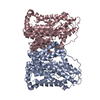
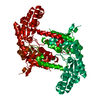

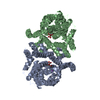


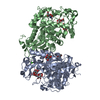
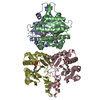
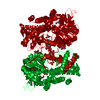
 Z (Sec.)
Z (Sec.) Y (Row.)
Y (Row.) X (Col.)
X (Col.)





















